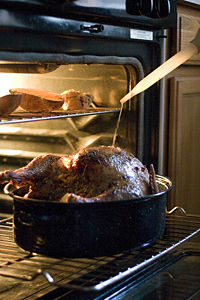Roast turkey: Difference between revisions
imported>Mary Ash |
imported>Hayford Peirce (added Mary Ash's image) |
||
| Line 1: | Line 1: | ||
{{subpages}} | {{subpages}} | ||
{{TOC|right}} | {{TOC|right}} | ||
{{Image|Turkey baster in use.jpg|left|200px|A turkey being basted during cooking in a turkey roaster.}} | |||
'''Roast turkey'''—the preparation of the whole bird as a meal for a large group of people—has a long tradition in North America | '''Roast turkey'''—the preparation of the whole bird as a meal for a large group of people—has a long tradition in North America | ||
that dates back to the time when wild turkeys were shot to be roasted on the campfire and continues to modern times | that dates back to the time when wild turkeys were shot to be roasted on the campfire and continues to modern times | ||
Revision as of 12:43, 17 October 2010
Roast turkey—the preparation of the whole bird as a meal for a large group of people—has a long tradition in North America that dates back to the time when wild turkeys were shot to be roasted on the campfire and continues to modern times when a domesticated turkey is prepared in the oven to be served at a family gathering, typically on Thanksgiving and also on Christmas Day. Turkeys, which originated in the Americas, also have a long tradition of being prepared in European countries such as England and France for festive occasions. Because of the large size of the typical turkey, it is almost always roasted whole rather than being cut into separate pieces for other types of preparation, as for the literally thousands of recipes for chicken for instance.
Because of industrial breeding processes, a medium-sized turkey of today would have been considered a very large turkey 50 years ago. Recipes for roast turkey dating to the mid-20th century often call for turkeys weighing between six and eight pounds.
The turkey should be cooped up and fed some time before Christmas. Three days before it is slaughtered, it should have an English walnut forced down its throat three times a day, and a glass of sherry once a day. The meat will be deliciously tender, and have a fine nutty flavor.[1]Mrs. Stephen J. Field's Statesmen's Dishes and How to Cook Them, 1890
Today a separate, boned turkey breast can be purchased that typically weighs the same amount, while whole turkeys weighing 20 to 30 pounds are easily found. Because of the industrialization of today's typical turkey, they have become increasingly difficult to roast satisfactorily: even the most talented home cooks find it difficult to roast a turkey so that the quick-cooking breast meat remains moist and tender while, at the same time, the thighs are thoroughly cooked.
Roasting methods
Many techniques and methods have been developed and proposed for the apparently simple roasting of a single bird: there are high-temperature recipes; very low-temperature recipes; mixed-temperature recipes; recipes in which the bird is cooked until the breast meat reaches a certain temperature and is then removed and kept apart while the rest of the turkey continues to cook; recipes in which the breast is covered with slices of salt pork; recipes in which the breast is draped with buttered cheesecloth; recipes in which the bird is covered with aluminum foil throughout most of its cooking; recipes in which the bird is turned in various ways throughout its cooking; and recipes in which it is cooked in a covered turkey roaster rather than in just the oven alone.
Stuffing
There are also thousands of recipes for various kinds of stuffing that can be cooked inside the roasting turkey. Each country has its own traditions for typical stuffing; although most of them involve breadcrumbs in one form or another, ingredients as exotic as oysters and chestnuts can also be found. It is opera legend that Enrico Caruso was served a spaghetti-stuffed turkey for his first Thanksgiving in the United States.
An alternative cooking method
The most popular innovation in recent years has been to submerse the entire bird in hot oil in a specially designed turkey deep-fryer rather than to roast it. Since this requires a large pot and dedicated high-heat source, this must be prepared outdoors for safety reasons. Deep-fat frying turkey is considered unsafe by the National Fire Protection Association. [2]
References
- ↑ The American Heritage Cookbook and Illustrated History of American Eating & Drinking, Vol. 2, Simon and Schuster, New York, 1964, page 483
- ↑ Turkey fryers. Retrieved on 2010-10-17.
